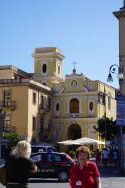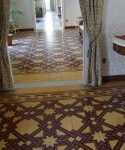Capri-cious
August 13, 2017
Heeding the strong northwest wind that more than rippled the waves, our captain changed course slightly today—we left Salerno at 5 am, bound along the Amalfi Coast for Sorrento, about 40 miles away.
While that meant we didn’t get to see much of the small villages tucked on high cliffs (I should have realized that the Saracens raided much of this area in the 16th century), it did get us to Sorrento with our bellies still full (one of  the hazards of a cruise is food!), and in time to sightsee in Sorrento, one of the larger cities on the Bay of Naples. Sorrento’s other claim to fame is in the Odyssey; it was where the Sirens lived. Fortunately, we did not hear them, since they lured sailors to their death.
the hazards of a cruise is food!), and in time to sightsee in Sorrento, one of the larger cities on the Bay of Naples. Sorrento’s other claim to fame is in the Odyssey; it was where the Sirens lived. Fortunately, we did not hear them, since they lured sailors to their death.

 We had about three free hours after a brief walking tour of the city, known for its limoncello, a liquor made from the ubiquitous lemon. The city sits on a cliff above the Bay, reached by a road through a fissure (or an elevator), its fort (damaged when Napoleon took the city) replaced with a plaza named for a famous local poet Tasso. Carolyn and I took the “city train,” which gave us a tour of the historic district, and then I was able to
We had about three free hours after a brief walking tour of the city, known for its limoncello, a liquor made from the ubiquitous lemon. The city sits on a cliff above the Bay, reached by a road through a fissure (or an elevator), its fort (damaged when Napoleon took the city) replaced with a plaza named for a famous local poet Tasso. Carolyn and I took the “city train,” which gave us a tour of the historic district, and then I was able to 
 return to a few museums. The local cathedral was built in the 14th century, with some artifacts from its predecessor, and an interior redone mostly in the baroque period. The church has several inlaid wood pieces that represent one of the crafts of the area (there’s a woodworking museum). It also has a bell tower that likely dates from the 8th century. The Saracen sack of the city in the 1550s required rebuilding of a lot of it.
return to a few museums. The local cathedral was built in the 14th century, with some artifacts from its predecessor, and an interior redone mostly in the baroque period. The church has several inlaid wood pieces that represent one of the crafts of the area (there’s a woodworking museum). It also has a bell tower that likely dates from the 8th century. The Saracen sack of the city in the 1550s required rebuilding of a lot of it.

 A little farther on the main street was the Villa Fiorentino, built in the early 20th century by a couple who made their fortune in handkerchiefs—and brought in an American architect to build a house later donated to the city. I went to the current Chagall exhibit, which filled six rooms.
A little farther on the main street was the Villa Fiorentino, built in the early 20th century by a couple who made their fortune in handkerchiefs—and brought in an American architect to build a house later donated to the city. I went to the current Chagall exhibit, which filled six rooms.
 We then were whisked to homes for lunch with local people. If farm to food is “in” in the United States, I suspect it never went “out” here. Our host families (an extended family of mom, daughter and son and families) gave us a tour of their farm (we were, I think in the city!) where they had two pigs, three cows, tomatoes, eggplant, zucchini, corn, and peppers (broccoli comes later); they were bottling tomato sauce, making wines (they bought the grapes), and served us a fresh meal. I should have known that the pasta was an appetizer, for what followed was another main dish with meatballs, salad, peppers, and wonderful bread, all prepared from fresh items for us. Not to mention homemade wines and limoncello.
We then were whisked to homes for lunch with local people. If farm to food is “in” in the United States, I suspect it never went “out” here. Our host families (an extended family of mom, daughter and son and families) gave us a tour of their farm (we were, I think in the city!) where they had two pigs, three cows, tomatoes, eggplant, zucchini, corn, and peppers (broccoli comes later); they were bottling tomato sauce, making wines (they bought the grapes), and served us a fresh meal. I should have known that the pasta was an appetizer, for what followed was another main dish with meatballs, salad, peppers, and wonderful bread, all prepared from fresh items for us. Not to mention homemade wines and limoncello.
When we came back to the boat, we learned that Greek god Aeoli’s failure to keep the winds in check meant a revision of the schedule, and so, instead of sailing up and back to Sorrento, we were going to detour to our next port by way of Capri (hence the pun for the title).

 Capri is a photogenic island, rocky but distinctive, with homes of many wealthy people, including, at one time, the famous ballet star, Rudolph Nureyev. We sat on deck for about an hour and learned about the island (one of many in the Gulf of Naples, a huge caldera in sight of Vesuvius).
Capri is a photogenic island, rocky but distinctive, with homes of many wealthy people, including, at one time, the famous ballet star, Rudolph Nureyev. We sat on deck for about an hour and learned about the island (one of many in the Gulf of Naples, a huge caldera in sight of Vesuvius).
Our guide told us that Jackie Kennedy was responsible for “Capri” pants. It’s said she liked Capri sandals so much that she had pants made that would let her show off the shoes. Hence was born a fashion trend that, from the tourists we saw in Sorrento, is still very much in vogue.
One other item: many Italian immigrants to the United States came from Naples, and so a lot of the music we think of as Italian is from here. Such as funiculi, funicula. The origins of that song, however, bring tears to my eyes as a marketer. It was an advertisement for a funicular company in Naples, urging people to ride to the top. Sounds better in Italian when you don’t know the meaning of the words!